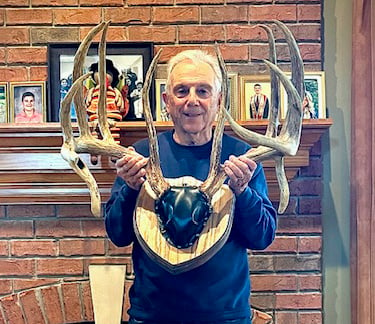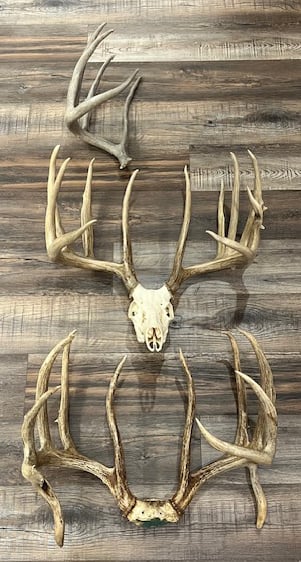Lost For 30 Years: New Potential #3 Whitetail and Illinois State Record Entered
By PJ DelHomme
A typical whitetail scoring 207-7/8 was stashed in an Illinois basement for 32 years until some electrical work needed to be done. When the electrician saw it, he was shocked!
After a long day of hunting pheasants in Lasalle County, Illinois, Sam Aiuppa put the dog away and climbed into a stand along the timber. He replaced birdshot with a slug in his Remington 870 shotgun and waited for evening. It was late November and the peak of the whitetail rut—the perfect time to find a buck with its guard down. After 40 minutes or so, a buck sauntered under his stand. Aippua shot it in the face.
Aiuppa told Rack Magazine that he was really more of bird hunter. “If you want to call it a fluke, I guess that’s what it is,” Aiuppa said. “I wasn’t that much of a deer hunter, even though I used to always buy deer tags.” This might explain why he skull-capped the antlers, nailed it to a plaque, and stuck it in the basement back in 1991.

More than thirty years later, Aiuppa needed help with an electrical issue at his house. A friend from his trapshooting club was an electrician and came over to help. Aiuppa showed the antlers to his friend, who “went bonkers.” Rough measurements were made, and the cat was officially out of the bag.
A New Owner
A few years after Aiuppa killed that giant Illinois buck, James Martin was just starting his landscaping business in New York. The business grew, allowing Martin to pursue other interests, such as whitetail antlers. Through the antler grapevine, Martin heard about the antlers and followed up.
After speaking with Aiuppa on the phone, Martin drove more than 600 miles from his home near Rochester, New York, to see Aiuppa’s deer himself. At 84, Aiuppa is “old school Italian,” Martin said. The two men chatted. Aiuppa told him of the hunt and why the deer stayed submerged in his basement for so long. “He’s just really into birds and not antlers,” said Martin. “I was thinking the deer might net 205, but when I saw it on the dining room table, I thought it would go higher.” Martin bought the antlers.
“I told my wife, who is very patient with this hobby, that this is the best deer I’ll ever put in this collection,” Martin said only half-joking. “Why is it tremendous? For one, it’s been missing for three decades. Then there are the sheds that another collector has from this deer. Once the picture of the rack came out, anyone who knew the sheds, knew what the deer was. If the sheds didn’t exist and it just popped up out of nowhere from 30 years ago, that would have been weird.”

The sheds of this buck were picked up in the 1990s, presumably while the buck was still alive. A farmer found one of them and tacked it to the side of his barn until a delivery driver offered him cash for it. According to Buckmasters, that shed scored 98-6/8 inches. The following year, James Albring found its last pair of sheds, which scored 95-0/8 (left) and 104-6/8, according to the North American Shed Hunter’s Club.
The Measurements
Martin says it was a no-brainer to get the antlers scored by a Boone and Crockett Club Official Measurer (OM). ‘ It doesn’t matter what score another outfit gives you; it only matters what score Boone and Crockett gives you.” He says OM Dave Boland scored the deer, whom Martin called the godfather of scoring. “He’s the most selfless guy you could ever meet. That’s how he is. He’s such a boon for the Club.”
“The cool thing about this deer is that when Boone and Crockett scores it, they score it as a 5x5, and it’s got nine inches of abnormal,” says Martin. “And that deer is still able to overcome that.” The Aiuppa buck doesn’t have a matching G-5 on the left, and those eye guards are more than a foot long.
“Sam and the deer deserve the credit,” Martin says. “This is Sam’s deer, and I’m a caretaker for now.”
Can't see the score chart? First you'll need to register on B&C’s website. It's FREE and takes less than a minute to complete. If you already have an account, simply log in to gain access.
Panel Scoring
Before the entry is official, Boone and Crockett Club procedures require that the final score of a potential top 10 of All-time be verified by an Awards Program Judges Panel. Awards Program Judges Panels are assembled once every three years, with the next awards judging panel being held in April 2025. At an Awards Program Judges Panel, two teams of two judges each measure the entry, and if the scores of both teams verify the original measurement, the panel will declare the score official.
Here's Sam Aiuppa reliving the day he swapped his birdshot for a slug and walloped a whopper in Illinois.
The Importance of Records in Big Game Management
When you enter your trophy into the Boone and Crockett system, you aren’t just honoring the animal and its habitat. You are participating in a data collection system that started in the 1920s and was refined by Club members in 1950.
Today, there are nearly 60,000 trophy records. By establishing a records database more than 70 years ago, the Boone and Crockett Club established a scientific baseline from which researchers can use to study wildlife management. If you’re still on the fence about entering your trophy, we encourage you to read Why Should I Bother to Enter My Trophy. To the best of our ability, we ensure that the trophies entered into the records were taken in accordance with the tenets of fair chase ethics. Despite what some may think, the Boone and Crockett records are not about a name or a score in a book—because in the end, there’s so much more to the score.

